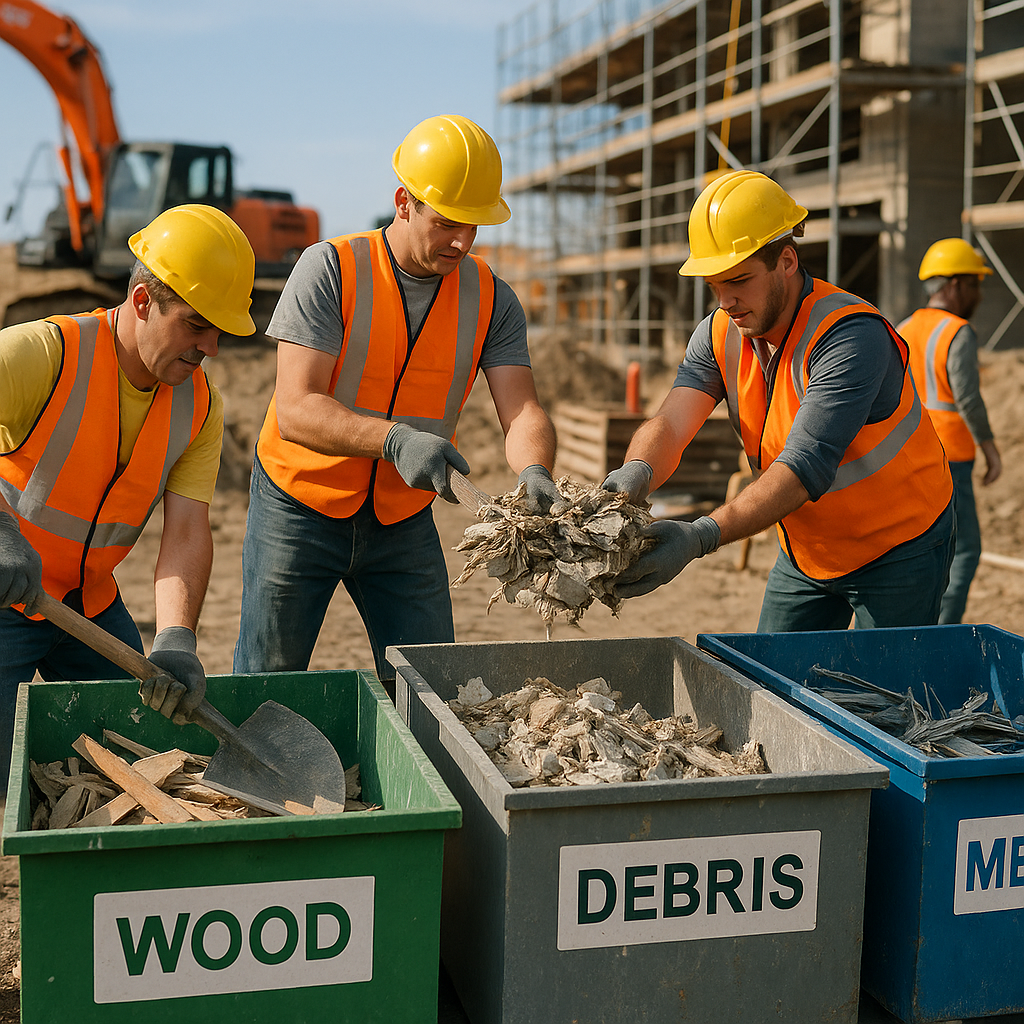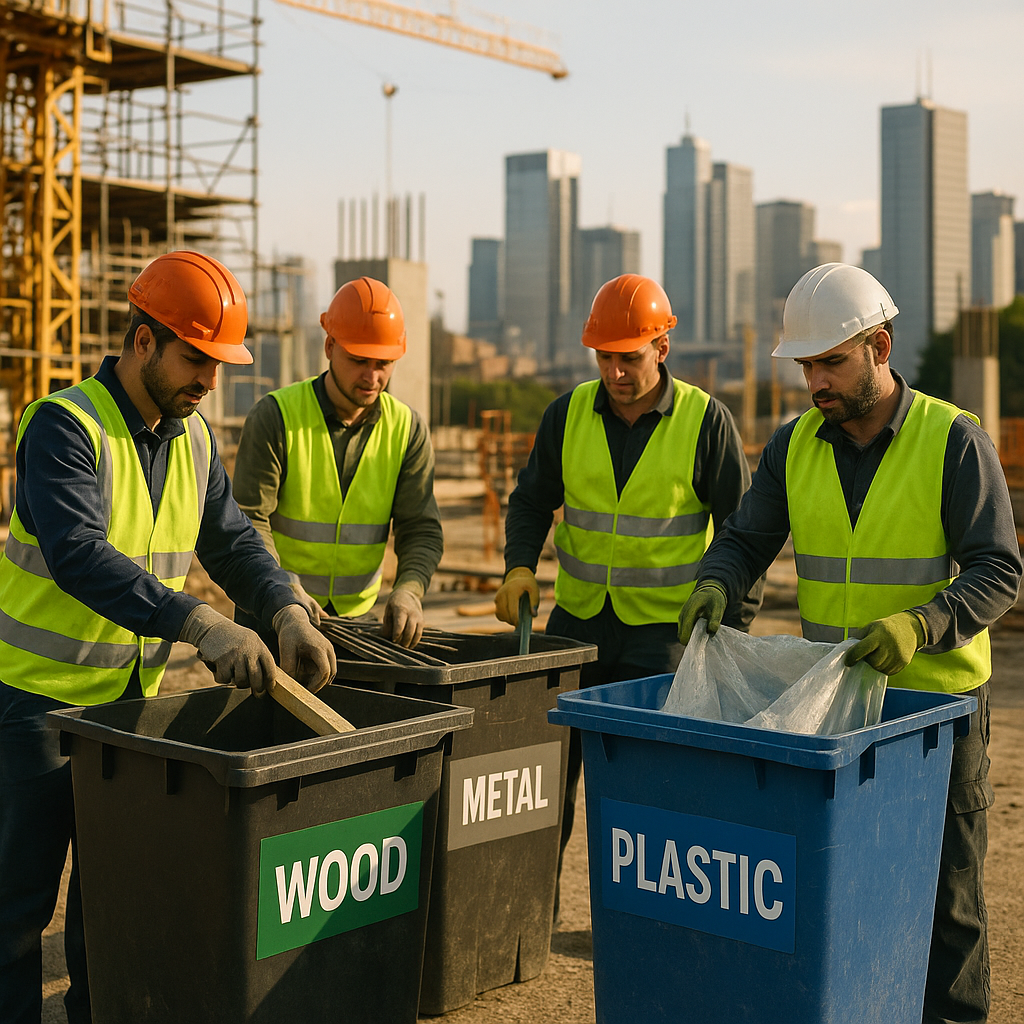5901 Botham Jean Blvd, Dallas, TX 75215
What is Construction Waste Separation and Why is It Important?
July 19, 2025Construction waste separation involves sorting and categorizing different types of waste materials generated at construction sites. This essential practice divides debris into specific categories such as concrete, wood, metals, plastics, and hazardous materials. Each type can then follow appropriate recycling or disposal pathways.
The construction industry accounts for approximately 30% of all waste produced globally. Without proper separation, these valuable materials often end up in landfills, contributing to environmental degradation and increasing project costs for contractors and developers.
Waste separation is a cornerstone of modern construction management. It directly impacts project efficiency, reduces operational costs, and supports environmental sustainability goals. Effective waste segregation systems transform what was once considered useless debris into valuable resources that can be recycled, reused, or properly disposed of.
How is Waste Separation Implemented on Construction Sites?

Effective waste separation on construction sites involves strategically placing multiple containers to collect different types of construction and demolition (C&D) waste. Contractors typically use separate containers for concrete, bricks, wood, metals, plastics, and other materials. This method provides immediate feedback to workers and fosters a responsible atmosphere that supports recycling goals. Workers can observe the sorting process, reinforcing proper disposal practices.
Successful implementation of waste separation requires careful planning and organization. Construction site managers must consider space availability, project phase, and material types when designing their waste management system. This thoughtful approach maximizes recycling potential while minimizing landfill contributions.
Practical Waste Separation Strategies
Construction sites often implement a variety of separation techniques based on project size and location constraints. Many projects use color-coded containers with clear signage to simplify sorting. This visual system helps workers quickly identify the appropriate disposal location for each material type.
Some common waste categories requiring separate containers include:
- Concrete and masonry (bricks, blocks, mortar)
- Wood (clean lumber, treated wood, engineered wood products)
- Metals (steel, aluminum, copper, brass)
- Drywall and plaster
- Plastics (PVC pipes, packaging materials)
- Cardboard and paper packaging
- Hazardous materials (paints, solvents, adhesives)
For projects with limited space, hybrid recycling approaches can be effective. This method combines site-separated and commingled recycling benefits. For example, a project might use individual containers for high-volume materials like concrete and wood while combining smaller waste streams. This balances weight against sorting effort and maintains recycling efficiency.
Worker Training and Implementation
The success of any waste separation program ultimately depends on worker participation. Comprehensive training programs ensure all site personnel understand the importance of waste segregation and know how to sort materials properly. Site superintendents should post clear guidelines for proper waste handling and conduct regular inspections to reinforce these practices.
Training typically covers identification of recyclable materials, contamination issues, and proper handling procedures. Regular refresher sessions help maintain awareness throughout the project lifecycle. Some sites designate waste management champions to monitor compliance and provide on-the-spot guidance.
At the Deepwater Industrial Park project, an effective waste separation system was implemented that exceeded standard practices. Concrete from adjacent demolished buildings was processed on-site using a temporary batch plant, transforming waste into crushed aggregate for new construction. This approach not only diverted significant waste from landfills but also reduced transportation costs and material expenses, demonstrating how thoughtful waste separation can create multiple benefits.
What Are the Key Challenges in Construction Waste Separation?

Construction waste separation presents significant challenges that affect sustainability goals and operational efficiency. These challenges range from practical limitations to management issues, hindering effective recycling and resource recovery efforts.
Space Constraints on Construction Sites
Limited space is one of the most common barriers to effective waste separation. Urban construction sites often lack adequate room for multiple collection containers needed to properly sort different materials. Without sufficient space for separate bins for concrete, wood, metal, and other materials, contractors resort to combining waste streams.
This issue is particularly acute in dense city environments where staging areas are already compressed. The result is mixed waste that requires additional processing downstream or may end up in landfills despite containing recyclable components.
Some projects address this challenge by implementing phased waste management approaches, adjusting container configurations as construction progresses from demolition to finishing work. This strategy maximizes limited space while maintaining separation standards.
Lack of Standardized Sorting Protocols
The absence of industry-wide standardized waste sorting systems creates confusion and inconsistency. When workers move between job sites with different sorting requirements, they struggle to maintain proper separation habits. Without clear, universal guidelines, materials often end up in incorrect containers.
Color-coded systems can help establish recognizable patterns, but these vary between companies and regions. The construction industry would benefit from consistent standards that create transferable knowledge between projects and reduce contamination of recyclable waste streams.
Training programs that emphasize standard separation practices are important for addressing this issue, though implementation remains inconsistent across the industry.
Management Oversight and Communication Gaps
Poor management oversight significantly undermines waste separation efforts. When supervisors fail to prioritize waste management, workers receive inadequate direction for proper sorting procedures. Without clear leadership emphasizing the importance of separation, convenience often takes precedence over sustainability.
Communication breakdowns between project stakeholders further complicate separation efforts. Architects, contractors, subcontractors, and waste management teams frequently operate in isolation, creating confusion about materials handling responsibilities. These silos lead to misunderstandings about which materials should be separated and how.
Successful waste separation requires establishing clear protocols before project commencement and reinforcing them consistently throughout all construction phases. Regular coordination meetings focusing specifically on waste management can help bridge these communication gaps.
Perceived Higher Costs
Many contractors view proper waste separation as financially prohibitive. The initial investments in multiple containers, training programs, and separation infrastructure appear costly compared to traditional mixed-waste disposal. This perception often deters the implementation of comprehensive separation systems.
However, this view overlooks potential cost benefits. Separated materials typically incur lower disposal fees and may generate revenue through recycling programs. Metal recycling, in particular, can offset other waste management expenses. Contractors who track these benefits often find that effective separation systems provide positive returns over project lifespans.
The industry needs better education about these financial advantages to overcome resistance based on perceived costs. Case studies demonstrating net savings can help shift this perspective.
Logistical Challenges in Transportation
Transporting separated waste streams creates logistical complexities beyond those of traditional mixed-waste disposal. Finding specialized haulers for different material types requires added coordination and scheduling. This can overwhelm project managers already dealing with tight construction timelines.
Some materials require specific handling or equipment for transportation, adding another layer of complication. Recyclable materials may need delivery to specialized facilities rather than standard waste processing centers, potentially increasing transportation distances and costs.
Building relationships with recycling facilities and waste management companies before project commencement can streamline these processes. Advance planning for transportation needs helps integrate waste separation into the overall project logistics framework.
Quality Control and Contamination Issues
Even when separation systems exist, maintaining quality control is an ongoing challenge. Contamination of recyclable streams with inappropriate materials can render entire loads unrecyclable. For example, clean wood contaminated with painted or treated wood may be rejected by recycling facilities.
Poor quality construction requiring rework compounds these issues. When tasks must be redone due to quality failures, materials that could have been properly sorted often get discarded hastily. The pressure to correct deficiencies quickly often outweighs waste separation considerations.
Enhanced quality control protocols that address both construction standards and waste separation can prevent these issues. Regular inspection of waste containers helps identify contamination problems before they affect entire loads.
What Are Effective Strategies for Minimizing Waste Through Separation?

A construction site showcasing a varied debris pile including concrete, wood, and metal scraps, set against a natural daylight urban background.
The construction industry generates significant amounts of waste. Without proper waste separation strategies, valuable materials end up in landfills, increasing environmental impact and project costs. Implementing systematic waste separation offers practical solutions that benefit both construction companies and the environment.
Design Phase Waste Minimization
Thoughtful design plays a crucial role in reducing construction waste before it’s generated. Architects and engineers can coordinate dimensions between structural elements and modular materials to minimize cutting and material offcuts. This simple planning step significantly reduces waste during construction.
Building Information Modeling (BIM) offers another effective tool for waste reduction. This technology enables three-dimensional coordination of all building systems, reducing on-site errors that typically generate waste. By identifying clashes between systems virtually, teams can avoid the waste associated with rework.
Designing buildings for deconstruction is a proactive approach to waste management. This involves using mechanical fixings rather than adhesives, making components easier to separate at the end of their useful life. Some projects now incorporate material passports that provide information about building materials to facilitate future reuse.
Prefabrication and Modular Construction
Off-site construction methods produce substantially less waste than traditional approaches. Components manufactured in controlled factory environments result in fewer errors, less rework, and more precise material usage. Some major projects using significant prefabrication have reported waste reductions of up to 90% compared to conventional methods.
Modular construction takes this concept further by creating entire building sections off-site. The controlled manufacturing environment allows for precise cutting and assembly, minimizing offcuts. Any waste generated can be more easily collected and recycled within the manufacturing facility rather than being scattered across job sites.
Standardizing building elements creates opportunities for repeatability and reduces the number of unique components needed. This streamlines the construction process while simultaneously reducing waste generation. The efficiency gained through standardization can significantly enhance overall project sustainability.
[[artifact_table]] Common construction materials and their waste reduction potential through prefabrication [[/artifact_table]]Material Selection and Management
Just-in-time purchasing reduces surplus materials that often become waste. This approach involves carefully timing material deliveries to align with construction schedules, minimizing storage time and potential damage. Working with suppliers who offer takeback programs for excess materials creates pathways for unused resources to return to the supply chain.
Choosing environmentally friendly materials with high recycled content supports waste reduction goals. Products certified under programs like Cradle to Cradle ensure materials remain in continuous circular loops rather than becoming waste. Some manufacturers now offer building systems as services, incentivizing durable, recyclable components.
Before disposing of materials, teams should evaluate opportunities for direct reuse within the project. Excavated soil can be reused for landscaping. Concrete from demolition can be crushed and used as aggregate for new concrete or as a base material for roads. Dedicated storage areas for reusable materials keep them organized and protected until needed.
On-Site Separation Techniques
A comprehensive Construction Waste Management Plan establishes protocols for on-site separation. This document should identify types of anticipated waste and establish specific procedures for handling each material stream. Setting clear diversion goals gives teams tangible targets to work toward.
Creating dedicated waste sorting stations is highly effective for proper material separation. These stations should include clearly labeled bins with visual guides showing which materials belong in each container. Strategic positioning throughout the site makes proper disposal convenient for workers.
Training workers on proper separation techniques ensures compliance with waste management protocols. Regular waste audits help identify areas for improvement and reinforce best practices. Some projects have found success by assigning waste management champions who oversee separation efforts and provide ongoing education.
Separation of Specific Materials
Different materials require specific handling approaches. Concrete and masonry waste should be separated for crushing and reuse as aggregate. Wood waste can be sorted by type, with clean lumber suitable for reuse or recycling and treated wood requiring special disposal.
Metals have significant recycling value and should be carefully sorted by type. Separate containers for ferrous and non-ferrous metals maximize their value. Drywall requires special attention as clean scraps can be recycled while contaminated pieces need different handling.
Packaging materials constitute a significant portion of construction waste. Establishing relationships with suppliers who minimize packaging or provide reusable options reduces this waste stream. Some sites implement cardboard balers to compress packaging for efficient recycling.
Technology-Enabled Waste Management
Digital tracking systems help monitor waste production and recycling rates. These tools provide real-time data that allows teams to identify problem areas and measure progress against diversion goals. Some systems even generate reports for regulatory compliance or green building certification.
Innovative sorting technologies are enhancing construction waste management. Advanced separation equipment can process mixed loads more efficiently than manual sorting. While typically found at recycling facilities, some larger projects bring mobile sorting equipment directly to the site.
Smart waste bins equipped with sensors can monitor fill levels and contamination. These systems alert management when bins need emptying or when improper materials are detected. The data collected helps optimize waste collection schedules and improve separation practices.
How Can Technology Enhance Construction Waste Separation?
The construction industry generates substantial waste that traditionally ends up in landfills. Technology now offers effective solutions to transform how construction waste is separated, tracked, and recycled, making these processes more efficient, accurate, and environmentally responsible.
Real-time Waste Tracking Systems
Advanced construction management software now includes waste tracking capabilities that provide real-time visibility into waste generation. These systems allow project managers to monitor materials from purchase through disposal, identifying excess and reuse opportunities. By documenting waste streams digitally, companies can analyze patterns and implement targeted waste reduction strategies.
Construction firms using digital tracking platforms report waste reductions of up to 30% through improved material ordering and handling processes. The data also supports regulatory compliance by providing accurate documentation of waste handling procedures.
IoT Devices and Smart Sensors
Internet of Things (IoT) technology is transforming waste management on construction sites. Smart sensors installed in waste containers can monitor fill levels, detect material types, and identify contamination in recycling streams. These sensors transmit data to central management systems, allowing for optimized collection schedules based on actual needs rather than fixed timelines.
Smart bins equipped with fill-level sensors can alert waste management teams when containers reach capacity, preventing overflow and ensuring timely collection. This reduces unnecessary pickups and avoids delays when bins fill quickly.
Some construction sites have implemented IoT-enabled waste monitoring systems using radar technology to accurately measure waste volumes. The collected data helps contractors understand waste generation patterns and adjust procurement practices to minimize excess.
Cloud-Based Collaboration Tools
Effective waste separation requires coordination among multiple stakeholders, including contractors, subcontractors, suppliers, and waste management companies. Cloud-based collaboration platforms enable all parties to access updated waste management plans, separation guidelines, and disposal procedures from any location or device.
These tools improve communication by providing a central repository for waste management documentation and real-time updates. When material specifications or recycling protocols change, everyone receives immediate notification, ensuring consistent application across the project.
Digital collaboration platforms also facilitate better planning for waste management logistics, allowing teams to coordinate material deliveries and waste removal to minimize site congestion and improve efficiency.
Automated Sorting Systems
Perhaps the most transformative technology for construction waste separation is automated sorting systems. These systems use a combination of robotics, artificial intelligence, and machine learning to identify and separate different materials with remarkable precision.
Advanced sorting facilities employ optical sensors, magnets, air classifiers, and robotic arms to sort mixed construction waste into clean, recyclable streams. AI-powered computer vision can distinguish between similar materials like different types of plastics or wood products that would be challenging for human sorters to identify quickly.
Material recovery facilities equipped with these technologies can process mixed construction debris and separate it into valuable commodities for recycling. This increases the percentage of waste diverted from landfills while producing higher-quality recycled materials that command better market prices.
Mobile Applications for On-Site Separation
Mobile apps designed specifically for construction waste management provide workers with instant guidance on proper separation procedures. These apps can include visual guides, barcode scanning for material identification, and location-based information about the nearest appropriate containers for different waste types.
Some applications incorporate gamification elements to encourage worker participation in waste separation efforts. By tracking individual or team contributions to recycling goals, these systems create positive competition that improves compliance with separation protocols.
Construction companies report that user-friendly mobile tools significantly improve separation accuracy at the source, reducing contamination in recycling streams and increasing the value of recovered materials.
Data Analytics for Continuous Improvement
The data collected through various technological solutions provides valuable insights for optimizing waste separation processes. Analytics platforms can identify trends, predict waste volumes, and recommend improvements to separation protocols based on actual performance.
By analyzing waste composition data over time, contractors can make informed decisions about material purchasing, prefabrication opportunities, and design modifications that reduce waste generation. This data-driven approach transforms waste management from a reactive disposal process to a proactive resource optimization strategy.
As these technologies continue to evolve and become more integrated, construction waste separation will become increasingly efficient and effective. The result will be significant reductions in landfill use, lower disposal costs, and greater recovery of valuable materials that can be returned to the supply chain in a true circular economy model.
Conclusion: The Future of Construction Waste Separation

Construction waste separation is a vital component of sustainable building practices, offering significant environmental and economic benefits. As the construction industry generates about 30% of global waste, implementing effective separation strategies is essential for reducing environmental impact and supporting resource conservation. By thoughtfully sorting materials such as concrete, metals, wood, and plastics, construction companies can significantly reduce landfill use and create opportunities for material recycling and reuse.
The future of construction waste separation will be shaped by technological innovation and increasing sustainability demands. AI-powered sorting systems, advanced materials recovery techniques, and digitally managed waste streams are set to transform how construction waste is handled. These technologies will enhance resource efficiency, minimize landfill waste, and support the industry’s shift toward more sustainable practices. For professional guidance on implementing effective waste separation strategies in your construction projects, contact Okon Recycling at 214-717-4083.
